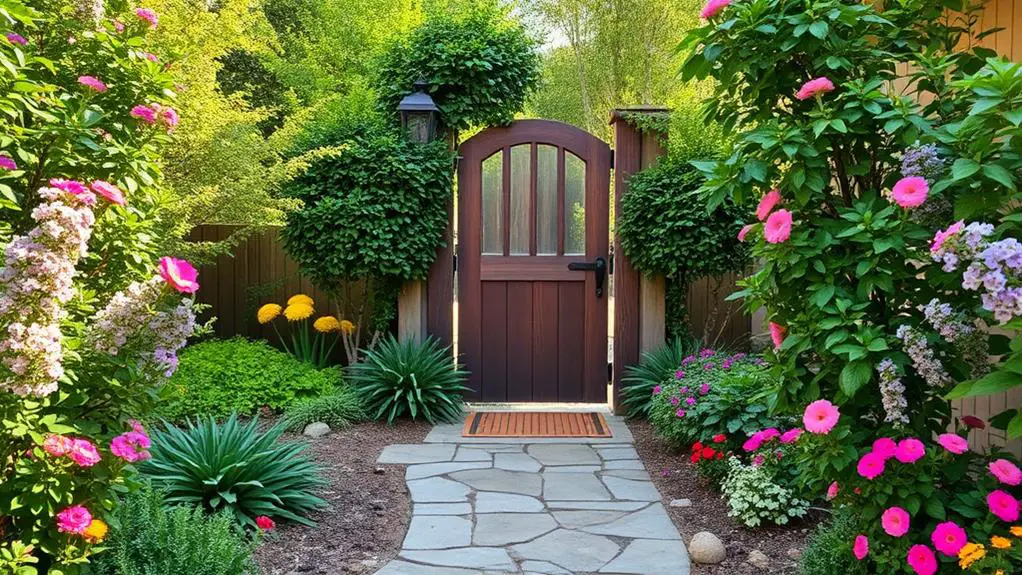As you envision your ideal laundry room, you’re likely thinking about more than just a functional space – you want an area that’s efficient, comfortable, and maybe even enjoyable.
You’re not alone in this desire; a well-designed laundry room can make a significant difference in your daily routine.
But where do you start? With so many layout options and design elements to ponder, it can be overwhelming.
Let’s take a closer look at some innovative ideas that will help you create a laundry room that truly works for you – and might just make you look forward to doing laundry.
Compact Corner Laundry Designs

In compact homes, you can cleverly carve out a functional laundry space by incorporating corner designs that maximize every inch of available real estate.
By doing so, you’ll create a practical and stylish area that’s perfect for tackling laundry tasks.
Corner shelves are a great way to start, providing ample storage for detergent, fabric softener, and other essentials.
You can also install a compact washer and dryer, designed specifically for small spaces, to save floor space.
To add some visual appeal, incorporate compact decor such as a small pendant light or a decorative wall shelf above the machines.
Consider a fold-down ironing board or a retractable drying rack to keep the floor clear.
With a little creativity, your compact corner laundry design can be both functional and fashionable.
Maximizing Space in Small Rooms
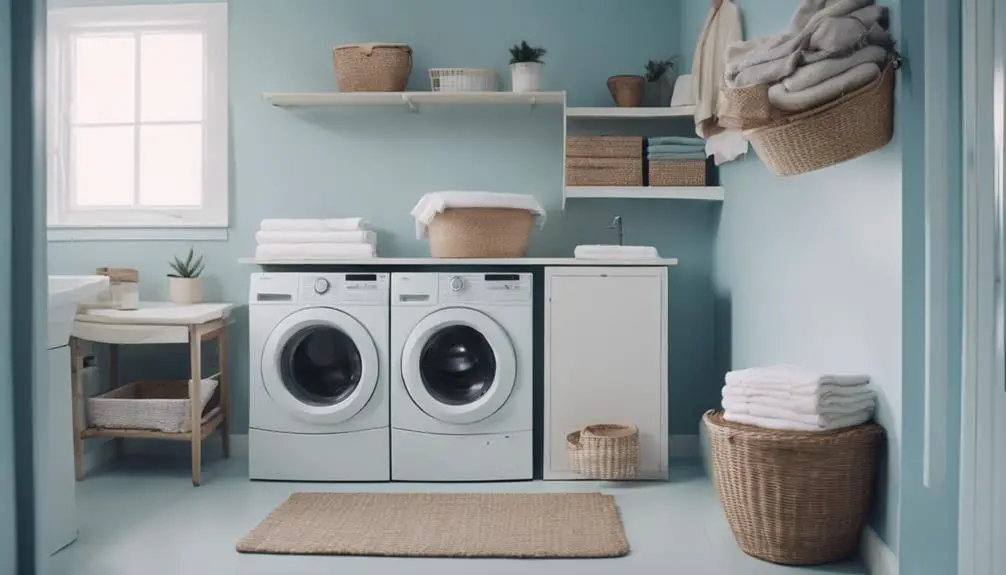
About 25% of small laundry rooms can be optimized by cleverly positioning the washer and dryer, allowing you to reclaim valuable floor space for additional storage or a folding station.
By placing them side by side, you’ll create a more open layout, making it easier to move around the room. Consider installing a pedestal or riser under the washer and dryer to elevate them, creating a sleek and modern look while also providing additional storage space underneath.
As you plan your layout, think about incorporating space savers like stackable shelves, hanging organizers, or retractable drying racks.
These efficient layouts will help you make the most of your small laundry room. Don’t forget to utilize the often-wasted space behind the washer and dryer by adding a slide-out shelf or storage cabinet.
With a little creativity, you can turn a cramped laundry room into a functional and stylish space that’s both efficient and enjoyable to use.
Folding Station Essentials
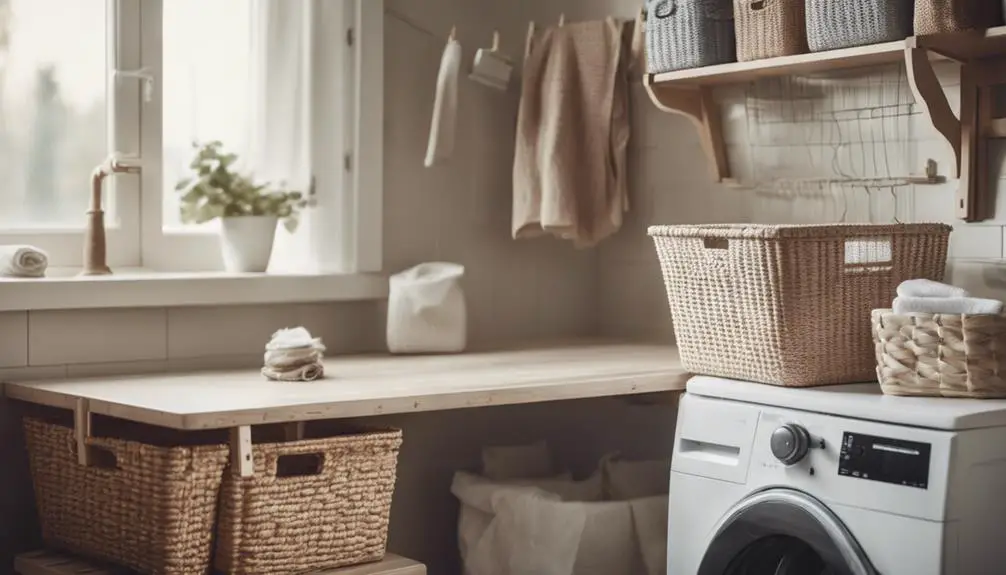
When designing your folding station, incorporate a sturdy, waist-high countertop with a smooth, easy-to-clean surface, allowing you to effortlessly fold and stack clothes without straining your back.
This will provide a comfortable and ergonomic space for you to work.
Next, consider the folding board features that will make your life easier.
Look for one with a built-in ironing board or a removable ironing board cover to create a seamless shift between folding and ironing.
Additionally, opt for a board with a built-in laundry sorter or a slide-out shelf to keep your supplies within reach.
To take your folding station to the next level, incorporate an ironing station with necessities like a built-in iron rest, a heat-resistant surface, and a cord organizer.
This will keep your ironing area tidy and organized, making the process more efficient.
Utilizing Vertical Storage
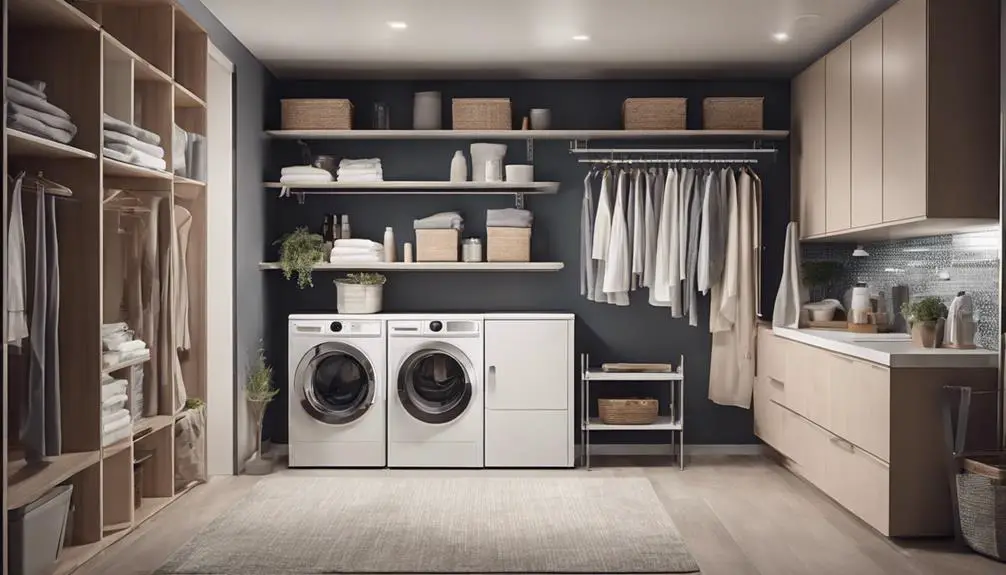
Maximize your laundry room’s vertical real estate by incorporating floor-to-ceiling shelves, cabinets, or storage units that keep supplies and accessories neatly stowed away, freeing up valuable floor space for your folding station and ironing area.
This strategic move allows you to make the most of your room’s dimensions, creating a sense of openness and airiness.
Install high shelves that can be accessed using storage ladders, providing a convenient way to store infrequently used items, such as out-of-season linens or special-care cleaning products.
Consider a pegboard with hooks for hanging items like ironing boards, laundry bags, or cleaning tools, keeping them off the floor and within easy reach.
By utilizing vertical storage, you’ll create a more streamlined and organized space that’s both functional and visually appealing.
Plus, with everything in its place, you’ll reduce clutter and make laundry day a whole lot easier.
Built-in Shelving Solutions
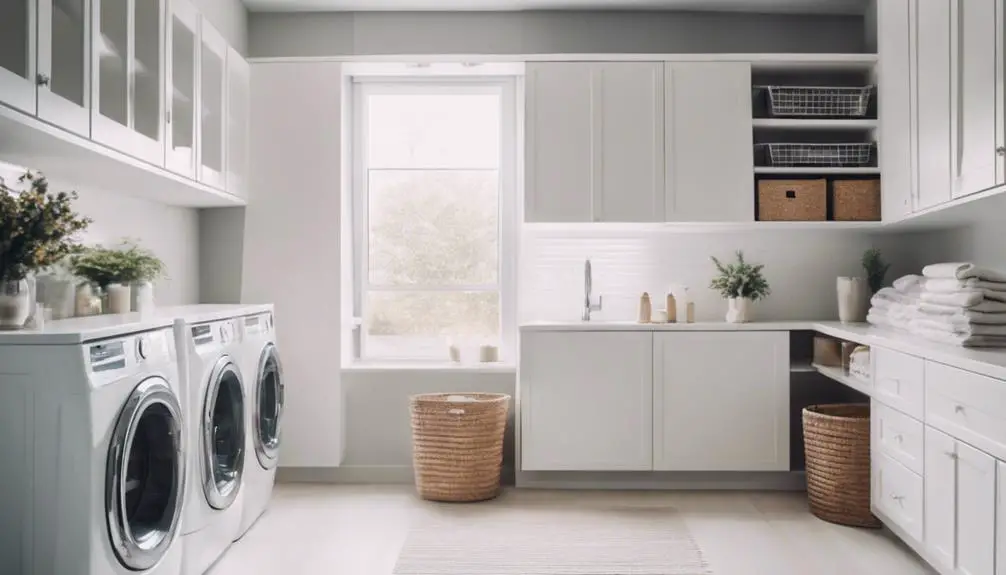
Two thoughtful built-in shelving solutions can be designed to fit snugly around your laundry room’s plumbing fixtures, cleverly concealing unsightly pipes while creating ample storage for laundry supplies and linens.
By incorporating custom designs, you can maximize your laundry room’s unique dimensions, ensuring a seamless blend of form and function.
Consider a wraparound shelving configuration that hugs the contours of your washer and dryer, providing easy access to frequently used items while keeping less-frequently used supplies tucked away.
Alternatively, a floor-to-ceiling shelving unit can be designed to fit behind a sliding door or panel, expertly hiding clutter while maintaining a sleek, streamlined aesthetic.
With built-in shelving solutions, you can create a laundry room that’s as beautiful as it’s functional.
Washer and Dryer Placement

As you envision your ideal laundry room, you’re probably thinking about the star players: the washer and dryer.
You’ll want to position them in a way that creates a seamless workflow, and a side-by-side arrangement against a wall is often the most practical and visually appealing choice.
This setup allows you to easily transfer clothes from washer to dryer, while also keeping the floor clear and the room feeling more spacious.
Side by Side
Positioning your washer and dryer side by side creates a sleek, streamlined look in your laundry room, allowing you to effortlessly transfer clothes from one machine to the other.
This layout is perfect for those who value efficiency and want to minimize the distance between the two machines. With side-by-side placement, you can easily load and unload clothes without having to walk around the room.
Additionally, this layout allows for maximum use of side space, which can be utilized for shelving, cabinets, or a folding station.
When choosing this layout, consider the load capacity of your washer and dryer. If you have a high-capacity washer, you may want to guarantee your dryer can handle similar-sized loads.
This will prevent you from having to run multiple cycles, saving you time and energy.
By thoughtfully planning your side-by-side layout, you can create a functional and stylish laundry room that meets your specific needs.
With a little creativity, you can turn this often-overlooked space into a hub of efficiency and productivity.
Against the Wall
By placing your washer and dryer against the wall, you’ll create a sense of continuity and flow in your laundry room, allowing your eyes to travel unobstructed along the surface.
This layout also frees up valuable floor space, making the room feel more spacious and airy. You can utilize the newly created space for additional storage or a utility sink.
To enhance the visual appeal, consider adding some wall decor above the appliances, such as a statement piece of art or a series of shelves for displaying decorative items.
When positioning your washer and dryer against the wall, make sure to leave enough space between them for easy loading and unloading.
This layout also allows for the installation of space savers like fold-down ironing boards or retractable drying racks, which can be mounted on the wall to maximize vertical space.
Laundry Room Workstation Ideas
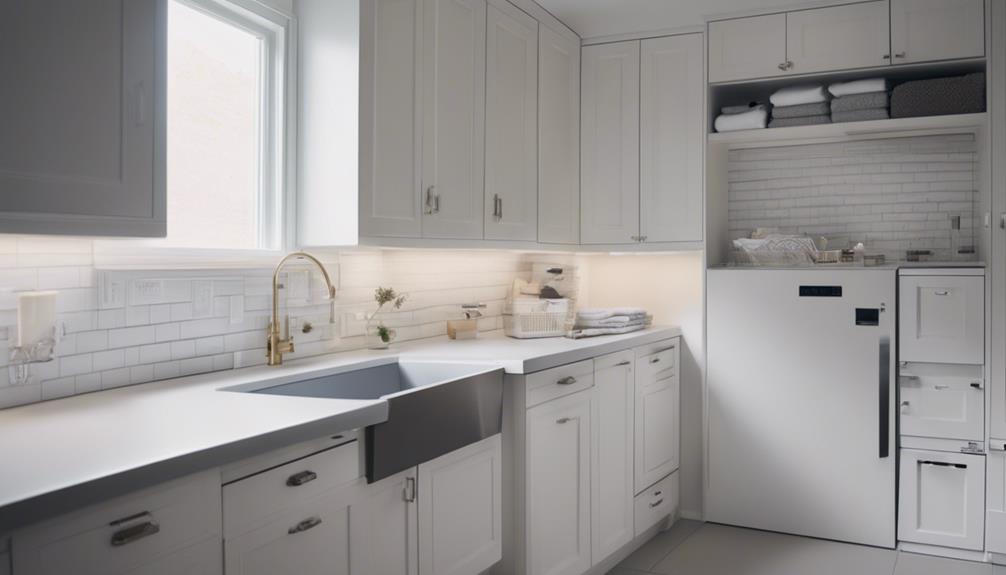
Your laundry room workstation becomes a haven of productivity when equipped with clever storage solutions and ergonomic design elements that cater to your unique workflow.
By incorporating laundry desk accessories, such as built-in ironing boards, pull-out drying racks, and slide-out baskets, you’ll have everything within easy reach.
A well-designed folding surface is also vital, with materials like stainless steel, granite, or butcher block providing a durable and stylish workspace.
Consider a countertop with a built-in sink or a wall-mounted folding table to maximize floor space.
Add some task lighting, like under-cabinet LEDs or a pendant light, to create a bright and inviting atmosphere.
You can also add some personal touches, such as a decorative wall art or a few potted plants, to make the space feel more welcoming.
With a little creativity, your laundry room workstation can become a space where you’ll actually enjoy spending time, making the chore of doing laundry a whole lot more bearable.
Hidden Utility Areas
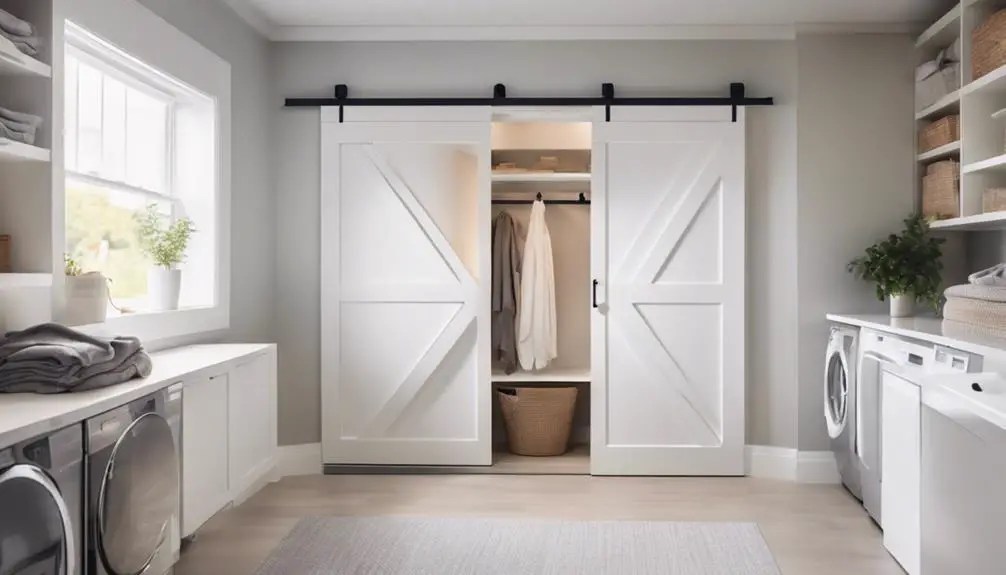
Behind sliding panels, cleverly concealed cabinets, or secret compartments, hidden utility areas await discovery, allowing you to stash away unsightly laundry essentials and maintain a clutter-free workspace.
You can cleverly tuck away laundry supplies, detergents, and fabric softeners in hidden nooks, keeping them out of sight but still within easy reach.
Consider installing a sliding panel that reveals a storage compartment, perfect for storing bulky items like laundry baskets or ironing boards.
Alternatively, opt for secret compartments hidden behind decorative trim or molding, ideal for stashing small items like lint rollers or stain removers.
When designing your hidden utility area, think vertically to maximize storage capacity.
Install shelves, cabinets, or drawers that rise to the ceiling, providing ample space for storing laundry essentials while keeping the floor clear.
Don’t forget to incorporate task lighting to illuminate your hidden utility area, making it easier to find what you need when you need it.
Incorporating a Sink Station

As you envision your ideal laundry room layout, consider anchoring the space with a sink station that serves as a central hub for sorting, soaking, and scrubbing, its presence elegantly streamlining your entire laundry process.
Strategically placing the sink near the washer and dryer creates a seamless workflow, allowing you to effortlessly rinse delicates or pre-treat stains. When it comes to sink placement, consider a corner installation to maximize floor space and create a sense of openness. A sleek, wall-mounted faucet adds a touch of modernity while keeping the countertops clear.
In terms of wet area design, incorporate a stylish and functional backsplash to protect the surrounding walls from water splashes. A decorative tile or glass panel adds visual interest and makes cleaning a breeze.
Additionally, consider a built-in drying rack or a pull-out drying drawer to keep your freshly washed items organized and out of the way. By thoughtfully incorporating a sink station into your laundry room layout, you’ll create a harmonious and efficient space that makes doing laundry a whole lot easier.
Functional Cabinet Designs

Incorporating clever cabinet designs that maximize storage and accessibility is crucial to maintaining a clutter-free laundry room, where every inch counts.
You’ll want to ponder cabinets with soft close drawers that glide smoothly open and shut, eliminating the noise and clutter of slamming doors. Customized inserts can also be tailored to fit your specific laundry needs, such as dedicated spaces for detergent, fabric softener, and stain removers.
Think about installing cabinets with adjustable shelves and baskets to accommodate different sizes of laundry supplies and accessories.
This will allow you to store items like ironing boards, laundry bags, and cleaning products out of sight, keeping your countertops clear and clutter-free.
Ponder adding a pull-out trash can or a slide-out ironing board to make the most of your cabinet space.
Open Shelving Laundry Layouts
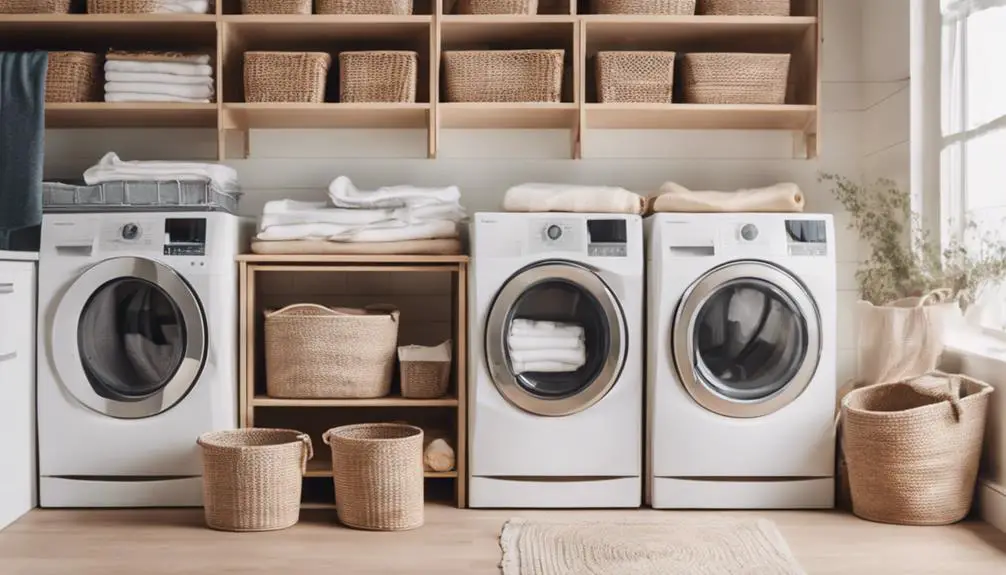
As you design your open shelving laundry layout, you’re probably thinking about how to maximize storage while maintaining a sense of airiness.
You’ll want to weigh the merits of fold-down shelf options that can be easily tucked away when not in use, as well as visible storage systems that add a touch of industrial chic to the space.
Fold-Down Shelf Options
Fold-down shelves in your open shelving laundry layout can be mounted at a comfortable height to provide easy access to laundry supplies and then folded up against the wall when not in use.
This fold-down convenience allows you to effortlessly retrieve and store items, keeping your laundry space organized and clutter-free. The shelf versatility also enables you to customize your storage needs, accommodating baskets, bins, and other containers of varying sizes.
When folded up, the shelves create a sleek, streamlined look that enhances the overall aesthetic of your laundry room.
You can choose from a range of materials, such as wood, metal, or glass, to complement your existing décor. Plus, fold-down shelves are perfect for small laundry rooms, as they maximize vertical space while keeping the floor clear.
Visible Storage Systems
By embracing visible storage systems, you create an open shelving laundry layout that puts your favorite laundry essentials on display, turning functional items into decorative accents that add visual interest to your laundry room.
This design approach celebrates the beauty of organization, making the most of your space while showcasing your personal style.
To make the most of your visible storage, consider incorporating storage bins in various shapes, sizes, and materials to add texture and depth to your shelves.
Labeling each bin will help maintain a sense of order and make it easy to find what you need at a glance.
Shelf dividers can also be used to separate items and create a sense of rhythm, drawing the eye along the shelf.
When choosing dividers, opt for slender profiles that won’t obstruct your view or create visual clutter.
Creating a Folding Area
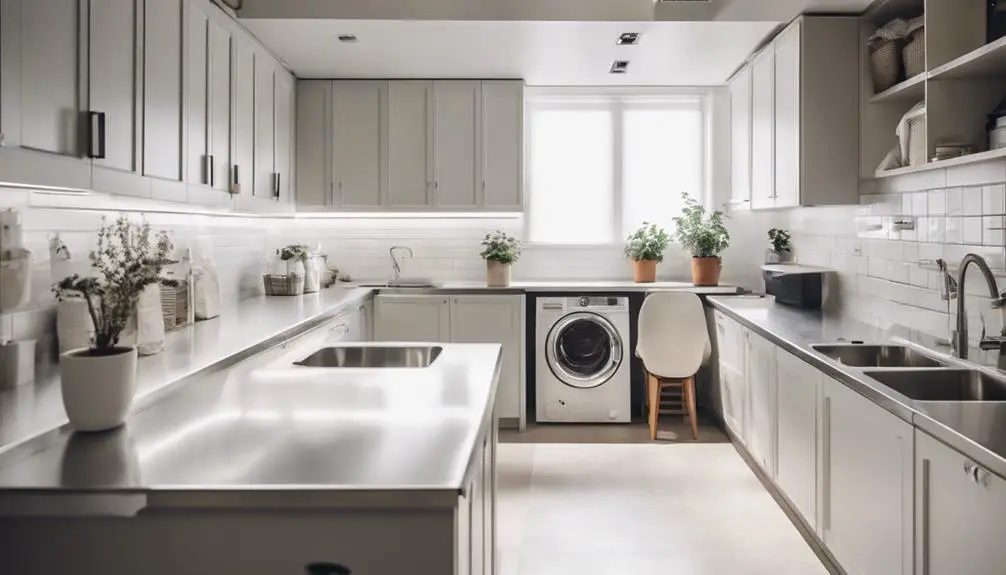
Your laundry room’s folding area becomes a hardworking hub where fresh-from-the-dryer chaos transforms into neatly stacked, crisp clothes.
As you design this space, consider your folding habits and how you can create an efficient workflow. Think about the ergonomics of folding: do you prefer to stand or sit while folding? Do you like to have a countertop or table surface to work on, or do you prefer a wall-mounted folding board?
Consider incorporating a countertop with a slight incline to reduce strain on your back and shoulders. A built-in ironing board or a slide-out shelf for your iron can also be a game-changer.
Think about the height of your folding surface – a comfortable height for you’ll make the task less tedious. You might also want to incorporate a hanging rod or a shelf above the folding area to store items like hangers, laundry bags, or folding boards.
Designing for Accessibility
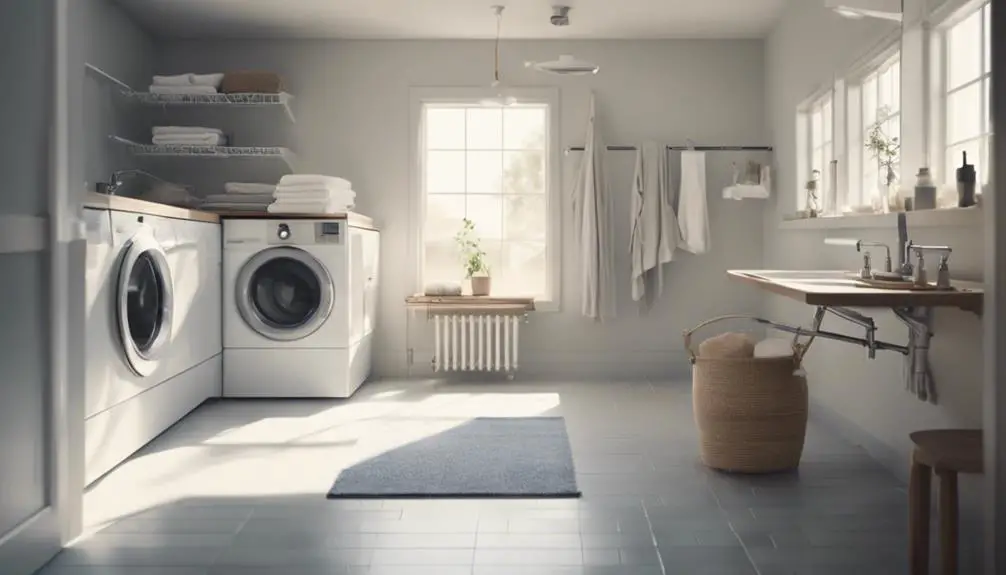
Designing for Accessibility
Incorporating universal design elements into your laundry room layout guarantees that the space remains accessible and comfortable for everyone, regardless of age or ability.
By prioritizing accessible design, you’ll create a laundry room that’s not only functional but also inclusive. Consider installing universal fixtures, such as lever-handled faucets and touchless soap dispensers, which are easy to operate for people with limited dexterity.
Place the washer and dryer at a comfortable height to reduce bending and straining. A roll-out shelf or drawer can also provide easy access to laundry supplies.
When planning your layout, think about the flow of traffic and confirm there’s enough clearance for a wheelchair or walker to pass through. A minimum of 42 inches of clearance is recommended.
You can also incorporate features like grab bars, non-slip flooring, and ample lighting to create a safe and accessible environment.
Frequently Asked Questions
Can I Install a Laundry Room on an Upper Floor or Only on the Ground Floor?
You can definitely install a laundry room on an upper floor, leveraging upper floor benefits like natural light and quieter operations, but be mindful of space constraints and carefully plan your layout to maximize functionality.
What Is the Ideal Temperature for a Laundry Room to Prevent Mildew?
To prevent mildew, you’ll want to maintain an ideal temperature between 68-72°F (20-22°C) and humidity levels below 50% in your laundry room. This combo will keep mildew at bay, ensuring a fresh and healthy space.
Are Laundry Room Exhaust Fans Necessary or Just a Good Idea?
You’re wondering if laundry room exhaust fans are necessary or just a good idea? They’re a must-have for improved air circulation and reducing fan noise, creating a fresh, mildew-free space that’s a blast of revitalization!
Can I Use a Laundry Room for Other Purposes, Like a Home Office?
You can repurpose a laundry room as a multi-functional space, like a home office, by creating a laundry nook and incorporating a storage station, allowing you to work efficiently while keeping clutter at bay.
Do I Need to Hire a Professional to Design My Laundry Room Layout?
When tackling a unique space design, you’ll consider your design constraints and personal preferences. If you’re unsure about balancing functionality and aesthetics, hiring a professional can help you tap your space’s full potential.
Conclusion
As you envision your ideal laundry room, remember to balance form and function.
By incorporating compact corner designs, maximizing space, and utilizing vertical storage, you’ll create a haven that’s both beautiful and efficient.
Thoughtfully design your folding station, shelving, and cabinetry to streamline tasks and reduce clutter.
With a focus on accessibility and attention to detail, your laundry room will become a space where chore time feels more like ‘me’ time.


